#html & css course
Explore tagged Tumblr posts
Text
4 Benefits Of Joining Top Course For Full-Stack Web Development

In the fast-evolving landscape of technology, web development stands as a crucial domain, and mastering full-stack web development has become a sought-after skill in the digital world. Batala offers an array of options for aspiring tech enthusiasts to embark on their journey to become proficient full-stack developers. Here are the four most spectacular advantages of enrolling in the best full-stack web development course in Batala.
Complete Skill Genius:
The foremost advantage lies in the comprehensive curriculum offered by the top full-stack web development courses in Batala. When you decide to join the best full-stack web development course in Batala, you must be very sure about checking if you get the best training. Here, you must ensure that the course involves top faculty members who have the skill and readiness to impart the best training.
Industry-Relevant Projects:
The best full-stack web development courses in Batala often integrate real-world projects into their curriculum. This hands-on experience allows students to apply their theoretical knowledge in practical scenarios. By working on industry-relevant projects, aspiring developers can grasp the complexities of web development and understand how to tackle challenges that mirror scenarios encountered in the professional world. This practical exposure greatly enhances their problem-solving abilities and boosts their confidence.
Networking and Career Opportunities:
Enrolling in the best full-stack web development course in Batala opens doors to extensive networking opportunities. Students often get the chance to connect with industry experts, potential employers, and fellow learners, fostering a community of like-minded individuals. This network can be a valuable asset when seeking internships, job placements, or collaborations in the tech industry.
Expert Guidance and Mentorship:
Top-notch courses in Batala are backed by experienced instructors and mentors who provide invaluable guidance throughout the learning journey. The presence of skilled professionals ensures that students receive personalized attention and mentorship, helping them navigate complex concepts and refine their coding skills. This guidance also extends to career advice, offering insights into the current trends in the tech industry and preparing students for the job market.
The Closing Thought:
Choosing the right full-stack web development course in Batala not only equips learners with the essential technical skills but also nurtures their overall development as successful professionals in the field of web development. The advantages encompass a robust curriculum, hands-on projects, mentorship, and extensive networking, paving the way for a promising career in the tech world.
youtube
#web development course#web development training#full stack developer course#full stack web development course#html css course#Youtube
0 notes
Text
A lot of people call making (mostly static) websites "coding" and fair enough honestly. But it always seems kind of weird to me. When I think of programming I think of the beauty in structure and natural abstractions that you design to communicate ideas, often based on mathematical truths. Meanwhile web development is pure hell, nothing works ever. If it's working then you forgot to test on some browser version that every one of your friends is using for some unknown cosmic reason. It's all opaque and nothing makes sense, there's no beauty, only ire. It only gets worse the deeper into "real" programming you go (Javascript etc.).
#programming#coding#of course it's more nuanced than this#you can make beautiful HTML/CSS/JS#you can make horrendous nonweb code#but deep down this is how I feel#intuitively
11 notes
·
View notes
Note
Idk if anyone's ever asked you this but how do you go about animating? i.e. what program do you use and what's your process?
I really wanna start animating but it seems like such a daunting task lol
okay lots of words so. under the read more lmao
toon boom harmony is industry standard 2d animation software so thats what i use for freelance work and more finished things like that antibodies animation (though i did the bg painting in procreate) – but totally not the ideal software for just starting out with animation lmao not to mention the fact that its a subscription :/// small sketches like that gif of bones i posted i'll sometimes tackle in procreate or procreate dreams, which are wayy more affordable and user friendly, even if theye a bit less robust.
if youre looking for a combination of robust software with the best price, blender is free and has 2d capabilities that ive messed around with a few times – its super cool, but the interface can be confusing if you've never worked in blender before and it has a bit of a steep learning curve BUT theres also always always always good ol paper and pencil, and nowadays most people own a camera and can access video editing software to stitch things together the best things to start out with are the basics, like a ball bounce animation, different weight objects falling, walk cycles – once you get an understanding of how timing works with animation, then tackling how characters move is the next step. just going into complex characters right off the bat is an easy way to get frustrated FAST lmao starting simple is always the way to go also a lot of cartoons and stuff move A Lot Less than you would think, a 10 second animation at 12 frames per second is almost never going to be 120 different individual drawings – sometimes you can just get away with a few blinks and a bit of lip sync to really sell an animation, so while animation does take a lot of time and effort try not to be too intimidated!!
#also there are a lot of youtube tutorials out there if that helps#im not too experienced with rigging and im hoping to give myself a crash course in harmony rigging sometime soon#maybe after i finish learning html+css lmao i gotta finish that video first#ask#ghostfrog81
51 notes
·
View notes
Text
The Importance of Investing in Soft Skills in the Age of AI
New Post has been published on https://thedigitalinsider.com/the-importance-of-investing-in-soft-skills-in-the-age-of-ai/
The Importance of Investing in Soft Skills in the Age of AI
I’ll set out my stall and let you know I am still an AI skeptic. Heck, I still wrap “AI” in quotes a lot of the time I talk about it. I am, however, skeptical of the present, rather than the future. I wouldn’t say I’m positive or even excited about where AI is going, but there’s an inevitability that in development circles, it will be further engrained in our work.
We joke in the industry that the suggestions that AI gives us are more often than not, terrible, but that will only improve in time. A good basis for that theory is how fast generative AI has improved with image and video generation. Sure, generated images still have that “shrink-wrapped” look about them, and generated images of people have extra… um… limbs, but consider how much generated AI images have improved, even in the last 12 months.
There’s also the case that VC money is seemingly exclusively being invested in AI, industry-wide. Pair that with a continuously turbulent tech recruitment situation, with endless major layoffs and even a skeptic like myself can see the writing on the wall with how our jobs as developers are going to be affected.
The biggest risk factor I can foresee is that if your sole responsibility is to write code, your job is almost certainly at risk. I don’t think this is an imminent risk in a lot of cases, but as generative AI improves its code output — just like it has for images and video — it’s only a matter of time before it becomes a redundancy risk for actual human developers.
Do I think this is right? Absolutely not. Do I think it’s time to panic? Not yet, but I do see a lot of value in evolving your skillset beyond writing code. I especially see the value in improving your soft skills.
What are soft skills?
A good way to think of soft skills is that they are life skills. Soft skills include:
communicating with others,
organizing yourself and others,
making decisions, and
adapting to difficult situations.
I believe so much in soft skills that I call them core skills and for the rest of this article, I’ll refer to them as core skills, to underline their importance.
The path to becoming a truly great developer is down to more than just coding. It comes down to how you approach everything else, like communication, giving and receiving feedback, finding a pragmatic solution, planning — and even thinking like a web developer.
I’ve been working with CSS for over 15 years at this point and a lot has changed in its capabilities. What hasn’t changed though, is the core skills — often called “soft skills” — that are required to push you to the next level. I’ve spent a large chunk of those 15 years as a consultant, helping organizations — both global corporations and small startups — write better CSS. In almost every single case, an improvement of the organization’s core skills was the overarching difference.
The main reason for this is a lot of the time, the organizations I worked with coded themselves into a corner. They’d done that because they just plowed through — Jira ticket after Jira ticket — rather than step back and question, “is our approach actually working?” By focusing on their team’s core skills, we were often — and very quickly — able to identify problem areas and come up with pragmatic solutions that were almost never development solutions. These solutions were instead:
Improving communication and collaboration between design and development teams
Reducing design “hand-off” and instead, making the web-based output the source of truth
Moving slowly and methodically to move fast
Putting a sharp focus on planning and collaboration between developers and designers, way in advance of production work being started
Changing the mindset of “plow on” to taking a step back, thoroughly evaluating the problem, and then developing a collaborative and by proxy, much simpler solution
Will improving my core skills actually help?
One thing AI cannot do — and (hopefully) never will be able to do — is be human. Core skills — especially communication skills — are very difficult for AI to recreate well because the way we communicate is uniquely human.
I’ve been doing this job a long time and something that’s certainly propelled my career is the fact I’ve always been versatile. Having a multifaceted skillset — like in my case, learning CSS and HTML to improve my design work — will only benefit you. It opens up other opportunities for you too, which is especially important with the way the tech industry currently is.
If you’re wondering how to get started on improving your core skills, I’ve got you. I produced a course called Complete CSS this year but it’s a slight rug-pull because it’s actually a core skills course that uses CSS as a context. You get to learn some iron-clad CSS skills alongside those core skills too, as a bonus. It’s definitely worth checking out if you are interested in developing your core skills, especially so if you receive a training budget from your employer.
Wrapping up
The main message I want to get across is developing your core skills is as important — if not more important — than keeping up to date with the latest CSS or JavaScript thing. It might be uncomfortable for you to do that, but trust me, being able to stand yourself out over AI is only going to be a good thing, and improving your core skills is a sure-fire way to do exactly that.
#ai#approach#Article#Articles#Artificial Intelligence#career#circles#code#coding#Collaboration#collaborative#communication#course#CSS#Design#designers#Developer#developers#development#factor#focus#Future#generative#generative ai#Giving#Global#hand#how#how to#HTML
4 notes
·
View notes
Text
Lime - wallpost/class overview
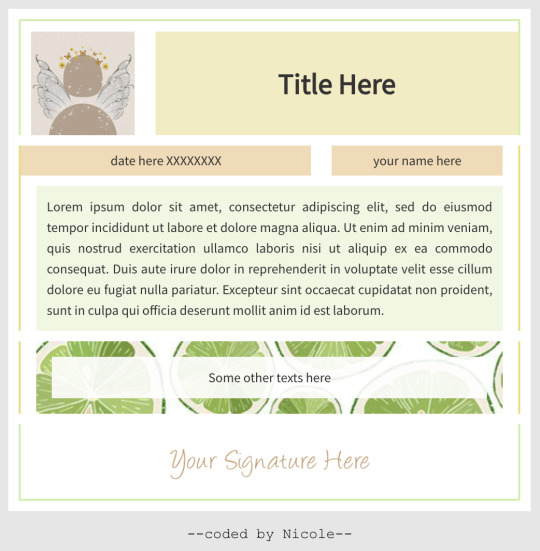
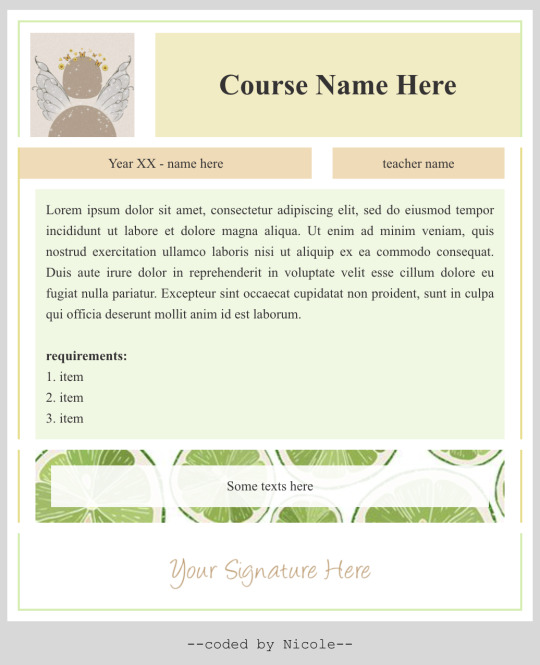
I finally finished my first ever class overview code that did not break right in front of my eyes HAHAHA
It took ridiculously long to get it right, so I hope it'll work for you too
Matching Article & Lesson code: here
Please read the TERMS OF USE before using my code <3
Link: v.1 (wallpost) || v.2 (class overview)
#wox#css#code#html#woxcode#free#wox wallpost#wallpost#course#class overview#nickycodes#coder's choice#overview
27 notes
·
View notes
Text

𝐘𝐨𝐮𝐫 𝐓𝐞𝐜𝐡 𝐂𝐚𝐫𝐞𝐞𝐫 𝐒𝐭𝐚𝐫𝐭𝐬 𝐇𝐞𝐫𝐞!
𝗪𝗮𝗻𝘁 𝘁𝗼 𝗯𝗲𝗰𝗼𝗺𝗲 𝗮 𝗙𝘂𝗹𝗹 𝗦𝘁𝗮𝗰𝗸 𝗗𝗲𝘃𝗲𝗹𝗼𝗽𝗲𝗿?
The tech world is booming, and skilled developers are in high demand! Learn both frontend & backend development and step into a high-paying career.
𝐖𝐡𝐚𝐭 𝐲𝐨𝐮’𝐥𝐥 𝐥𝐞𝐚𝐫𝐧: ✅ Frontend: HTML, CSS, JavaScript, React ✅ Backend: Node.js, Express, MongoDB ✅ Real-world projects & hands-on training
Don’t just dream about coding—make it your profession!
Transforming Passion into Profession!
✆ 𝗖𝗮𝗹𝗹/𝗪𝗵𝗮𝘁𝘀𝗔𝗽𝗽 on +𝟵𝟭-𝟴𝟰𝟱𝟱𝟬 𝟮𝟭𝟬𝟵𝟬 🌐 𝗪𝗲𝗯: www.giniskills.com
#giniskills#TechCareers#webdesign#webdevelopment#training#websitedesign#Courses#skills#webdesigner#careers#html#css#javascripttutorial#fullstackdevelopercourse#frontend#backend#LiveProjectTraining#HighPayingCareers#MongoDB#coding#skilleddevelopers#DreamCareer#bhubaneswarbuzz#Odisha#Bhubaneswar
4 notes
·
View notes
Text
When I figure out how to use css and html, so I can do useless customizations on random apps, it’s over for everybody. 👤
#html css#my blogs#my websites#my anki cards#everything is gonna be decked out for no reason#it was so easy and fun when I was taking courses on it but I just stopped out of nowhere 💀
2 notes
·
View notes
Text
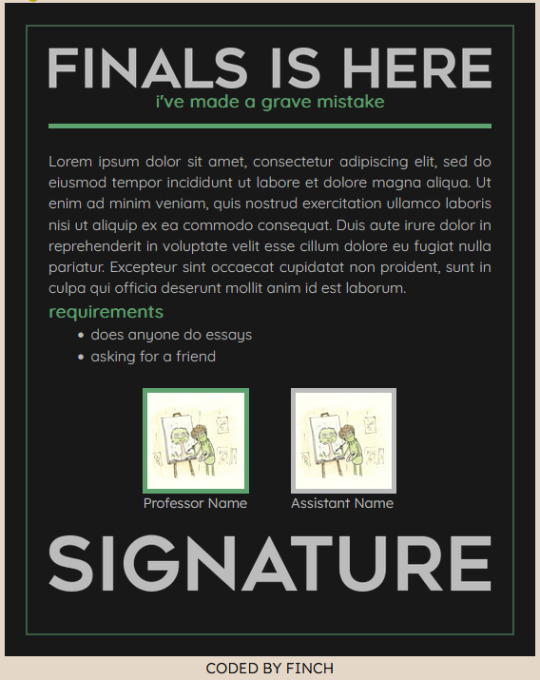
finals is here | course overview a friend of mine requested a silly little course overview with my previous article code, but this can also function as a wallpost too once again only inline css so you'll have to find the colors manually to switch out (5ea26f, rgba(94, 162, 111, 0.5), bbbbbb, good luck) title is font meme there is no god pastebin
#coding#world of olympians#world of potter#html#html template#css#wox site#wox#course overview#wallpost
12 notes
·
View notes
Text
all these coding classes lately remind me that i gotta work on my website sooner or later...
#now that im actually taking school courses for html/css im realizing its notttt that bad#like its Frustrating as hell but im better than i thought i was. thats for sure#I WOULDVE worked on my site earlier this year i just got hit by irl shit. yknow how it is#anyway i want to talk here more. i have so many thoughts and i have so little time to dump them.......aaaaaaaa#guess i had to take a step away from using the internet too much. and that break lasted for. What. A few years now LOL#i need to post more of my art here.. havent posted my art to tumblr since 2022 i dont think.."???? Mental illness sorry#ANYWAY ig going out of my way to talk to ppl outside my friendgroup more has done me wonders mentally. bc now im not feeling shy/Scared#like. at all anymore#also im moving next year so hopefully thatll give me the energy to work on stuff again!#chat.txt#ohyeah i need to like. redo my blog theme + work on toyhouse page a bit more#ok gn
2 notes
·
View notes
Text
oh my fucking god i understand the hexadecimal system
#LEARNING IS SO FREAKING COOL DUDE !!!!!!!!!!!!!!! ITS NOT JUST THROWING RANDOM LETTERS IN THERE FOR NO REASON IT TURNS OUT#im doing a web development course and for a while it was all review bc i just picked up a lot of html and css in middle school#by reverse engineering tumblr theme codes lol. but now its getting into a lot of reasons *why* some code stuff works the way it does#and its blowing my mind#emily.docx
7 notes
·
View notes
Text
Decode Learning: Your Path to Full Stack Proficiency
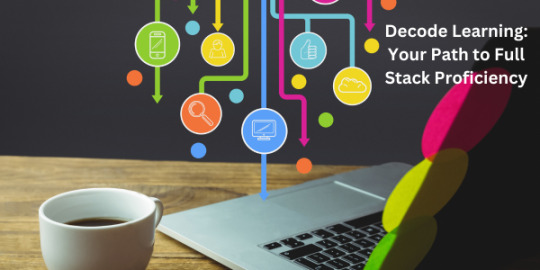
Navigate the complexities of full stack development through our tailored course. Become adept at building end-to-end applications and thrive in the coding realm. https://bit.ly/3qpgGXq
0 notes
Text
Learn HTML and CSS: A Comprehensive Guide for Beginners
Introduction to HTML and CSS
HTML (HyperText Markup Language) and CSS (Cascading Style Sheets) are the core technologies for creating web pages. HTML provides the structure of the page, while CSS defines its style and layout. This guide aims to equip beginners with the essential knowledge to start building and designing web pages.
Why Learn HTML and CSS?
HTML and CSS are fundamental skills for web development. Whether you're looking to create personal websites, start a career in web development, or enhance your current skill set, understanding these technologies is crucial. They form the basis for more advanced languages and frameworks like JavaScript, React, and Angular.
Getting Started with HTML and CSS
To get started, you need a text editor and a web browser. Popular text editors include Visual Studio Code, Sublime Text, and Atom. Browsers like Google Chrome, Firefox, and Safari are excellent for viewing and testing your web pages.
Basic HTML Structure
HTML documents have a basic structure composed of various elements and tags. Here’s a simple example:
html
Copy code
<!DOCTYPE html>
<html>
<head>
<title>My First Web Page</title>
<link rel="stylesheet" type="text/css" href="styles.css">
</head>
<body>
<h1>Welcome to My Web Page</h1>
<p>This is a paragraph of text on my web page.</p>
</body>
</html>
: Declares the document type and HTML version.
: The root element of an HTML page.
: Contains meta-information about the document.
: Connects the HTML to an external CSS file.
: Contains the content of the web page.
Essential HTML Tags
HTML uses various tags to define different parts of a web page:
to : Headings of different levels.
: Paragraph of text.
: Anchor tag for hyperlinks.
: Embeds images.
: Defines divisions or sections.
: Inline container for text.
Creating Your First HTML Page
Follow these steps to create a simple HTML page:
Open your text editor.
Write the basic HTML structure as shown above.
Add a heading with the tag.
Add a paragraph with the tag.
Save the file with a .html extension (e.g., index.html).
Open the file in your web browser to view your web page.
Introduction to CSS
CSS is used to style and layout HTML elements. It can be included within the HTML file using the <style> tag or in a separate .css file linked with the <link> tag.
Basic CSS Syntax
CSS consists of selectors and declarations. Here’s an example:
css
Copy code
h1 {
color: blue;
font-size: 24px;
}
Selector (h1): Specifies the HTML element to be styled.
Declaration Block: Contains one or more declarations, each consisting of a property and a value.
Styling HTML with CSS
To style your HTML elements, you can use different selectors:
Element Selector: Styles all instances of an element.
Class Selector: Styles elements with a specific class.
ID Selector: Styles a single element with a specific ID.
Example:
html
Copy code
<!DOCTYPE html>
<html>
<head>
<title>Styled Page</title>
<link rel="stylesheet" type="text/css" href="styles.css">
</head>
<body>
<h1 class="main-heading">Hello, World!</h1>
<p id="intro">This is an introduction paragraph.</p>
</body>
</html>
In the styles.css file:
css
Copy code
.main-heading {
color: green;
text-align: center;
}
#intro {
font-size: 18px;
color: grey;
}
CSS Layout Techniques
CSS provides several layout techniques to design complex web pages:
Box Model: Defines the structure of an element’s content, padding, border, and margin.
Flexbox: A layout model for arranging items within a container, making it easier to design flexible responsive layouts.
Grid Layout: A two-dimensional layout system for more complex layouts.
Example of Flexbox:
css
Copy code
.container {
display: flex;
justify-content: space-around;
}
.item {
width: 100px;
height: 100px;
background-color: lightblue;
}
Best Practices for Writing HTML and CSS
Semantic HTML: Use HTML tags that describe their meaning clearly (e.g., , , ).
Clean Code: Indent nested elements and use comments for better readability.
Validation: Use tools like the W3C Markup Validation Service to ensure your HTML and CSS are error-free and standards-compliant.
Accessibility: Make sure your website is accessible to all users, including those with disabilities, by using proper HTML tags and attributes.
Free Resources to Learn HTML and CSS
W3Schools: Comprehensive tutorials and references.
MDN Web Docs: Detailed documentation and guides for HTML, CSS, and JavaScript.
Codecademy: Interactive courses on web development.
FreeCodeCamp: Extensive curriculum covering HTML, CSS, and more.
Khan Academy: Lessons on computer programming and web development.
FAQs about Learning HTML and CSS
Q: What is HTML and CSS? A: HTML (HyperText Markup Language) structures web pages, while CSS (Cascading Style Sheets) styles and layouts the web pages.
Q: Why should I learn HTML and CSS? A: Learning HTML and CSS is essential for creating websites, understanding web development frameworks, and progressing to more advanced programming languages.
Q: Do I need prior experience to learn HTML and CSS? A: No prior experience is required. HTML and CSS are beginner-friendly and easy to learn.
Q: How long does it take to learn HTML and CSS? A: The time varies depending on your learning pace. With consistent practice, you can grasp the basics in a few weeks.
Q: Can I create a website using only HTML and CSS? A: Yes, you can create a basic website. For more complex functionality, you'll need to learn JavaScript.
Q: What tools do I need to start learning HTML and CSS? A: You need a text editor (e.g., Visual Studio Code, Sublime Text) and a web browser (e.g., Google Chrome, Firefox).
Q: Are there free resources available to learn HTML and CSS? A: Yes, there are many free resources available online, including W3Schools, MDN Web Docs, Codecademy, FreeCodeCamp, and Khan Academy.
#how to learn html and css#html & css course#html & css tutorial#html and css#html course#html css tutorial#html learn#html learn website#learn html#learn html and css#html and css course#html and css full course#html and css online course#how to learn html and css for beginners
3 notes
·
View notes
Text
Responsive Animated Website With HTML & CSS
youtube
#html#tamilitmemes#css3#tamilwebdesign#css animation#web development#web design#website#webdesign#youtube#responsivewebdesign#responsive design#responsive webdesign#responsive web design#webdev#htmlcodes#htmlcss#learn html#html5#html course#css tutorial#html css#html5 css3#css#htmlcoding#frontenddevelopment#javascript#csstricks#websitedesign#website development
5 notes
·
View notes
Text
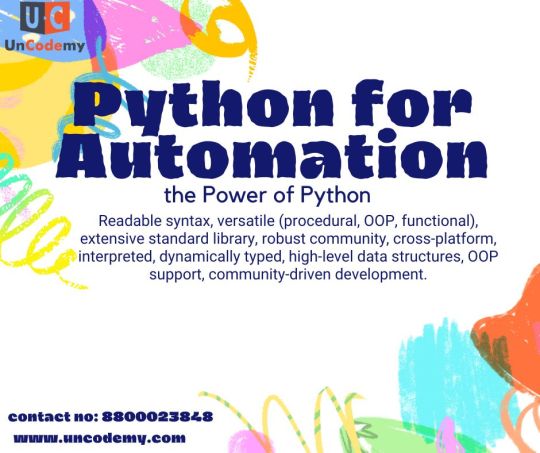
Discover how to use Python for web scraping, a potent method of obtaining data from websites. BeautifulSoup and Requests are two Python packages that make this process easier and allow for the smooth parsing of HTML structures.
#Best python course in kanpur#python#programming#coding#java#javascript#programmer#developer#html#snake#coder#code#computerscience#technology#css#machinelearning#pythonprogramming#linux#ballpython#php#datascience#reptile#snakes#reptiles#snakesofinstagram#software#reptilesofinstagram#webdevelopment#webdeveloper#tech
8 notes
·
View notes
Text
you'd think that taking a container box and copying it to the other side of your neocities would be easy
it
no
#ashton is talking#neocities#y'know maybe taking a crash course on html/css would be helpful even if i'm just using a template#apparently it's more complex than “copy - paste - rename box so it's a separate thing - tweak some things”#i will persevere though#i'll figure it out eventually#(of course i'd accept help-)
3 notes
·
View notes
Text

WEB DESIGN COURSES
2 notes
·
View notes